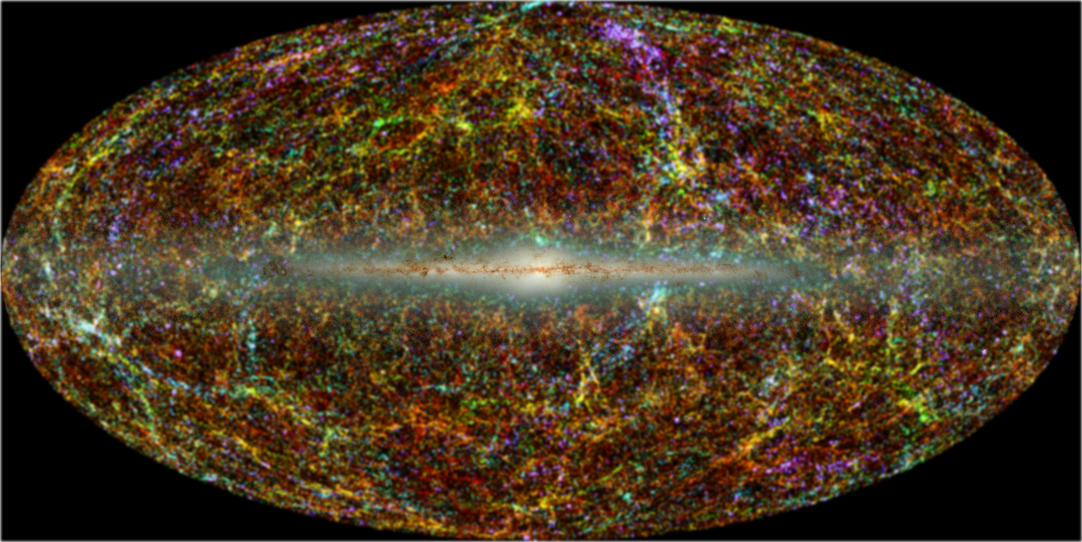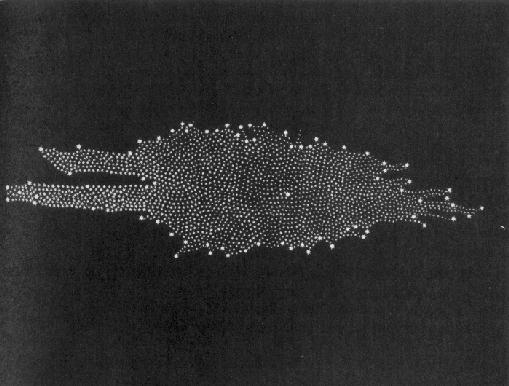 |
| The Infrared Local Universe: this all-sky map shows galaxies in the 2MASS survey color coded by their distance from us with blue showing the nearest sources, through green to the most distant sources shown in red. Read more about this image here. |
Take a tour through the 2MRS data: Quicktime movie
See the redshift layers being added: Quicktime movie
The 2MASS redshift survey (2MRS) is the latest in a series of efforts led by scientists at the Harvard-Smithsonian Center for Astrophysics to map the universe.
2MRS uses a list of galaxies provided by the 2 Micron All-Sky Survey and plans to measure redshifts to all of them down to a certain brightness. 2MASS detects galaxies in the near infra-red part of the spectrum, light which is emitted from old stars in the galaxies and is therefore representative of the galaxy's total mass in stars. Infrared radiation is also much less affected by the "dust" in our own Galaxy. In optical light more than 30% of the extragalactic sky is hidden from our view by this absorbing material, while in the near infrared less than 10% is blocked.
Mapping the Universe
Since the beginning of the scientific era (and before) one of the main goals of Astronomy has been simply to map the universe that we live in. This started with efforts to measure the size of the Earth, and the distance to the Sun and in the last 20 years has reached the point where we believe we are mapping the largest structures in the universe.
Herschel's Universe

The scientific work of William Herschel (1738-1822) lays some of the most important foundations for the work of the 2MASS redshift survey. Not only did Herschel discover the infrared radiation with which we are selecting the galaxies to measure distances to, but he was also a pioneer in the mapping of "spiral nebulae" (what we know call spiral galaxies). With his sister Caroline, William created an extensive catalog of nebulae using the then enormous 40 foot telescope in the garden of his house in England. Herschel also constructed the first map of the size of our own Galaxy, estimating the distances to stars in it by assuming they all were instrinically the same brightness. His map of the Galaxy in which he placed the Sun near the centre (the brighter spot) is shown in the image to the right.
The Great Debate
In the early part of the 20th century there was a lot of discussion amongst scientists over the size of the universe and the nature of "spiral nebulae". One group of scientists believed that the Milky Way (the galaxy we live in) was very large, and included all observable objects in the universe (including the nebulae), while another group believed it was much smaller and that the "spiral nebulae" were in fact all other galaxies similar to our own. In 1920 a famous debate was held between two prominent scientists of the time. Harlow Shapley argued the evidence for "one big galaxy", in which the Sun was off to one side while Heber Curtis argued that the galaxy was much smaller, the Sun was near its centre, and the spiral nebulae were external. As with many arguements they were both right in some ways. The galaxy is much larger than Curtis thought and the Sun is now known to be far from its center, however the nebulae are definitely known to be external making the universe as a whole is much larger than either Astronomer could have imagined at the time.
Hubble and Redshifts
Edwin Hubble provided some of the evidence which partially settled the great debate in the mid 1920s. His observations of M31 proved conclusively that it must be another galaxy like our own. Hubble is also famous for his work on the redshifts of galaxies. He cannot be credited for discovering that the light from galaxies is almost always shifted to the red, but he did notice that there was a correlation of the amount of redshift and the distance to the galaxy. This correlation is now known as Hubble's Law.
The CfA Redshift Survey

Because of Hubble's Law, measuring the redshifts of galaxies is virtually equivalent to measuring a distance to them. Redshifts are the distance measure of preference for many Astronomers because they are independent of the exact details of cosmology, which are required to transform them to distances in units of length (like kilometers, light years or "Megaparsecs").
The CfA Redshift Survey was started in 1977 by Marc Davis, John Huchra, Dave Latham and John Tonry. The First CfA Survey, completed in 1982, produced the first large area and moderately deep maps of large scale structure in the nearby universe. It showed that the universe was not homogeneous as had previously been believed, but that galaxies and clusters of galaxies reside in a filamentary network of "superclusters". The famous "CfA Stick Man" in the image to the left is an example of such a supercluster. The structures are leftover remnants of the initial density fluctuations in the early universe and are expanding with the universe. Galaxies are thought to flow along the filaments towards galaxy clusters which form at the intersections.
The second CfA survey (CfA2) was started by John Huchra and Margaret Geller in the winter of 1984/5. Between 1985 and 1995, they and their students and co-workers measured relative distances via redshifts for about 18,000 bright galaxies in the northern sky.
On going redshift surveys
The current generation of redshift surveys is taking advantage of recent developments in telescope technology which allows many spectra to be taken at once to provide much larger numbers of galaxy redshifts. Surveys fall into two general strategies. Those like the Sloan Digital Sky Survey and 2dF Galaxy Redshift Survey measure redshifts for very faint galaxies (at very large distances) but only in a relatively narrow area of the sky; others like the 2MASS Redshift Survey plan to map redshifts evenly over the whole sky (6dF Galaxy Redshift Survey in the whole southern sky) but not to as large a distance. Both strategies provide useful and complementary information about the largest structures in the universe and about the local large scale structure.
|
Page maintained by Karen Masters: kmasters
'at'
cfa.harvard.edu |
